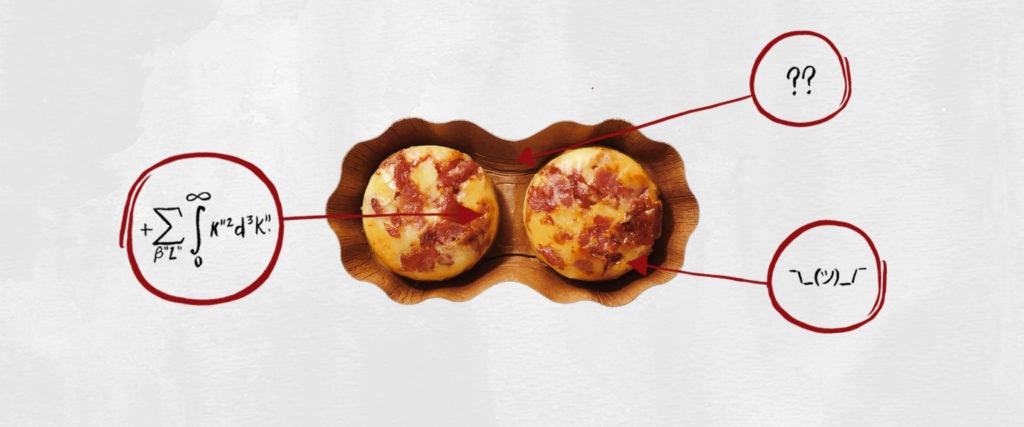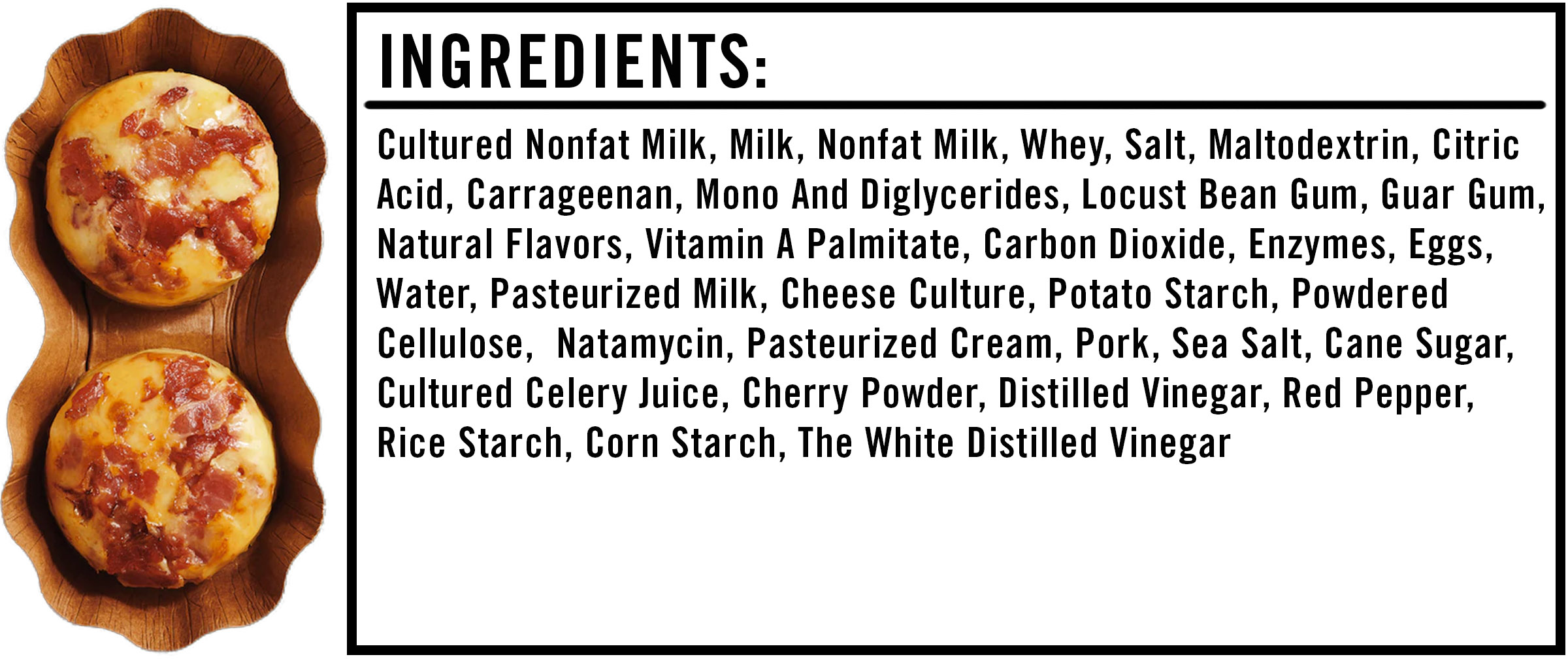We’re often told that you should never eat anything (or put anything on your body) if you don’t recognize everything on the ingredients list. But since most of us have no idea what xanthan gum or potassium benzoate are — or more importantly, what they’re doing to our bodies — we’re decoding the ingredients in the many things Americans put in (and on, or near) themselves.
This edition: Starbucks Bacon & Gruyère Sous Vide Egg Bites, which are made from more than 30 separate ingredients that we’ve broken down as they appear on the Starbucks website.
The Cottage Cheese
1) Cultured Nonfat Milk: Milk is cultured by adding the lactic acid bacteria Streptococcus lactis, which results in an acidic, zesty and thick milk product, which is also known as cultured buttermilk.
2) Milk: Cows spurt this.
3) Nonfat Milk: Nonfat milk is milk without fat, duh.
4) Whey: Whey is essentially the liquid leftovers after milk has been curdled and strained. It’s usually added to processed foods as a source of protein and to add bulk.
5) Salt: One serving of two egg bites contains 680 milligrams of sodium, or 30 percent of your daily recommended intake.
6) Maltodextrin: An artificial sugar made from maltose (aka malt sugar) and dextrose (a sugar derived from starches), maltodextrin is usually used as a thickener or filler ingredient to add bulk to processed food and to increase its shelf life. (Maltodextrin itself has a shelf life of two years.)
7) Citric Acid: Citric acid naturally occurs in citrus fruits and is often added to foods to extend their shelf life.
8) Carrageenan: This is widely used in the food industry for its gelling, thickening and stabilizing properties. Some animal studies argue that there’s a connection between carrageenan ingestion and inflammatory bowel disease; however, the FDA lists the ingredient as a Generally Recognized as Safe Substance. And more recent human studies take the FDA’s side on this one.
9) Mono And Diglycerides: This ingredient is typically added to food products as an emulsifier. But as I learned in my exploration of all 39 ingredients in the Dodger Dog, mono and diglycerides are oftentimes packed with trans fats that aren’t listed on the nutrition facts label, which is incredibly problematic. That’s because trans fats are associated with an increased risk of heart disease, stroke and diabetes, and consuming more than you think you are (because they weren’t listed on the label) could do serious damage to your body.
10) Locust Bean Gum: Locust bean gum is a natural food additive derived from carob seeds. It’s used primarily as a thickening and stabilizing agent.
11) Guar Gum: Guar gum is made from guar beans and acts as a stabilizer and thickener to improve texture.
12) Natural Flavors: It’s hard to say what exactly this natural flavor is, but more generally, natural flavors are flavors derived from an actual food source — i.e., cheese flavoring taken from real cheese.
13) Vitamin A Palmitate: This is a compound that acts as a source of vitamin A, which supports vision and the immune system. Vitamin A is naturally abundant in milkfat; however, the skimming process implemented to create reduced fat milk results in the loss of vitamin A, which is why manufacturers often add it back in as vitamin A palmitate.
14) Carbon Dioxide (To Maintain Freshness): Carbon dioxide prevents the growth of mold and bacteria, and it’s often used to fill up the air in packaging.
15) Enzymes: Enzymes help cheese curdle.
The Eggs
1) Eggs: From chickens.
2) Citric Acid: See above.
3) Water: That stuff in lakes.
The Cheese Blend
1) Monterey Jack Cheese: Cheese with some spice.
- Pasteurized Milk: Milk that’s been heated to kill pathogens.
- Cheese Culture: Cheese culture accelerates the process of coagulating milk into cheese.
- Salt: For flavor.
- Enzymes: See above.
2) Gruyere Cheese: This cheese melts well.
- Pasteurized Milk: See above.
- Cheese Culture: See above.
- Salt: See above.
- Enzymes: See above.
3) Potato Starch: A starch extracted from potatoes (obviously), which serves to thicken this cheese blend.
4) Powdered Cellulose: Made by cooking raw plant fiber, powdered cellulose is simply a filler ingredient used to stretch pricier ingredients, like cheese.
5) Natamycin (A Natural Mold Inhibitor): A mold inhibitor produced by bacteria, natamycin has been widely accepted as a natural alternative to chemical preservatives. It’s also used to treat fungal eye infections, which may leave a bad taste in your mouth (metaphorically speaking). But multiple studies have shown natamycin to be completely safe for human consumption.
The Unsalted Butter
1) Pasteurized Cream: The fatty portion of milk.
2) Natural Flavors: See above.
The Uncured Bacon No Nitrites or Nitrates Added Except as Naturally Occurring in Sea Salt and Celery Juice Powder
1) Pork: Meat from pigs.
2) Water: More H2O.
3) Sea Salt: Salt from the sea, which contains a negligible amount of nitrates and nitrites, preservatives that are commonly associated with cancer, especially when they come from meat sources.
4) Cane Sugar: As we learned in our ranking of sugars, cane sugar is one of the healthier options, since it boasts high amounts of vitamins, minerals and antioxidants.
5) Cultured Celery Juice: Like sea salt, celery juice contains nitrites and nitrates, which give cured meats their distinct color, aroma and flavor. When nitrites and nitrates come from vegetable sources like celery, they’re healthier than they’d be otherwise.
6) Cherry Powder: Cherry powder is a natural replacement for sodium erythorbate, a meat curing ingredient that can cause problems like headaches, dizziness, fatigue, lethargy and body flushing.
The Hot Sauce
1) Distilled Vinegar: Vinegar produced from the fermentation of distilled alcohol. The extra acidity it provides helps enhance the flavor and acts as a preservative. Vinegar also adds a bit of an extra tart punch to the sauce.
2) Red Pepper: For heat.
3) Salt: It’s everywhere!
Everything Else
1) Rice Starch: This helps the egg bites thicken up and hold together.
2) Corn Starch: This does the same thing as rice starch.
3) Salt: Yep, more salt.
4) The White Distilled Vinegar (Diluted With Water To 4 Acidity): This adds some acidity to the egg bites, probably to help round out all the fat and salt.
The Takeaway
While I’m both impressed and disgusted at the sheer number of ingredients in a tiny egg sphere that can sit comfortably in the palm of my hand, I can’t say any of them are that terrible for you. In fact, in some cases, like with cultured celery juice and cherry powder, Starbucks appears to be choosing natural ingredients over their artificial counterparts.
All in all, there are far, far worse things on the Starbucks menu.


